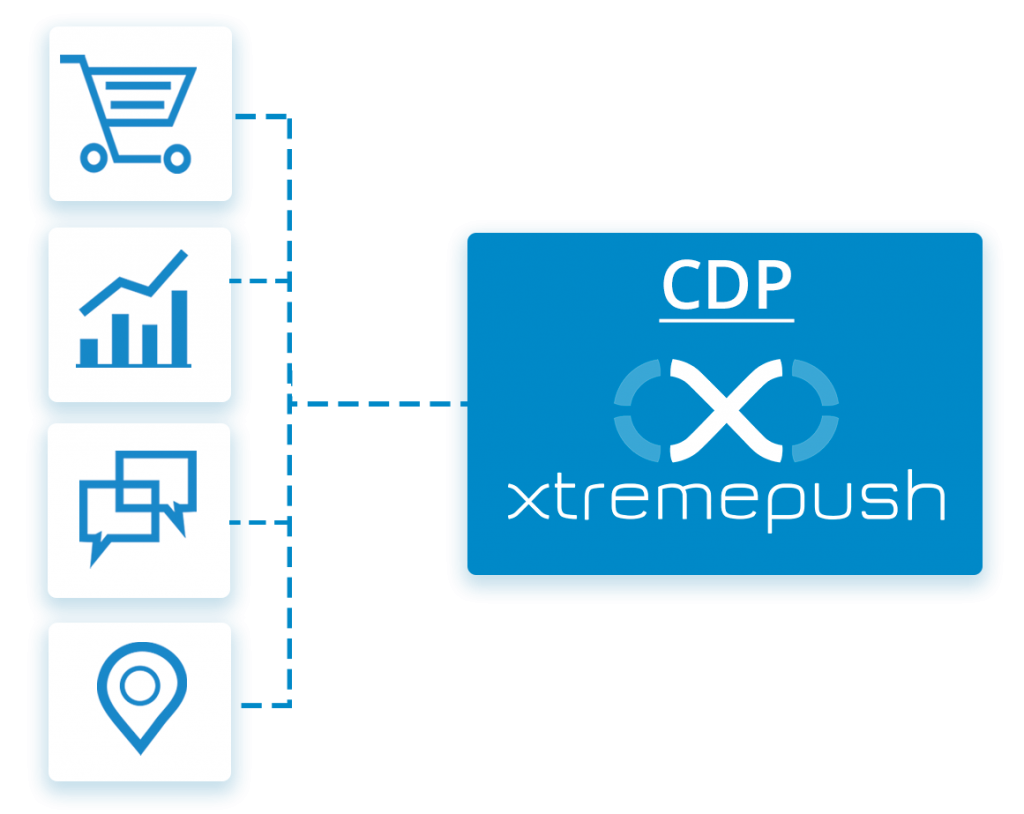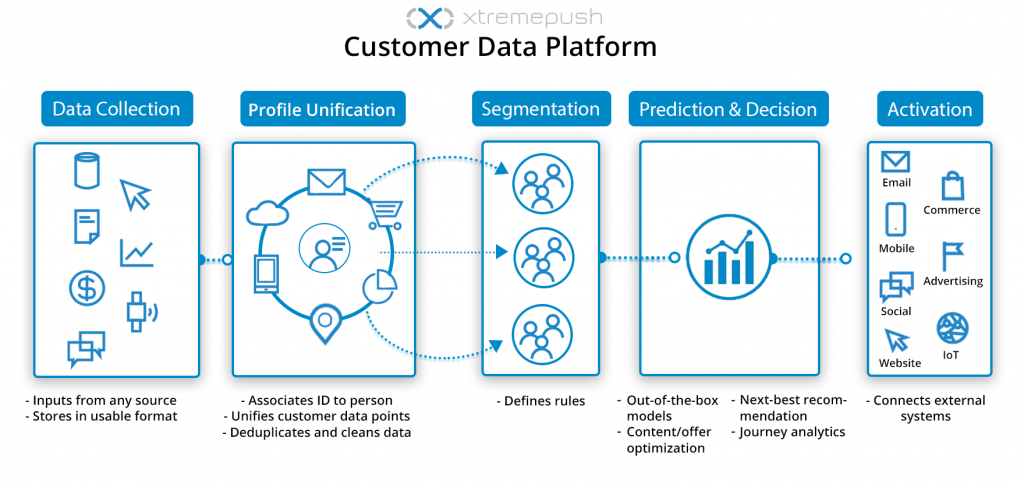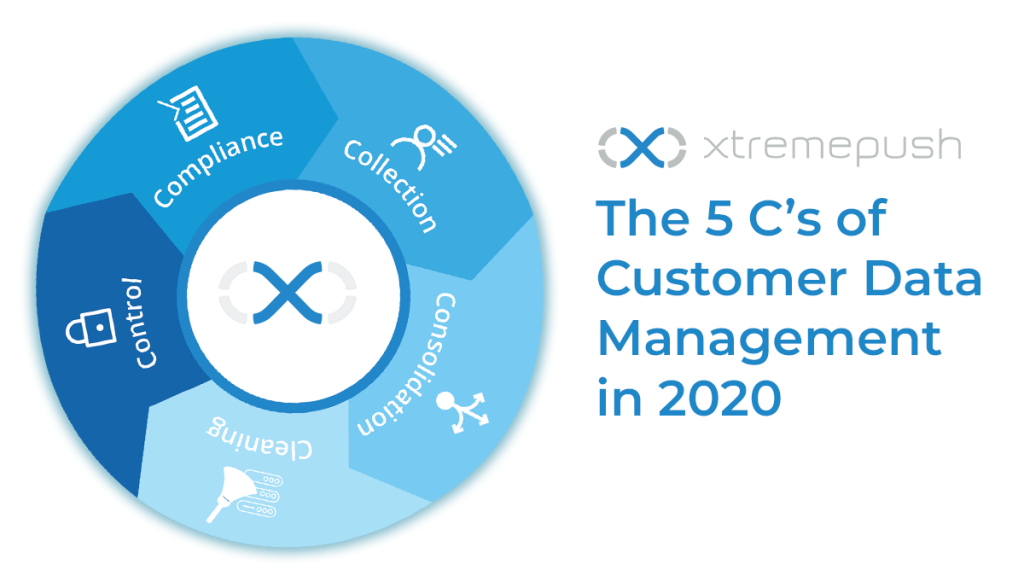What is Customer Data Management in 2020?
Customer Data Management is a holistic framework that governs the way an organisation collects, stores, unifies, cleans and activates (or makes use of) the data available.
In recent years, the challenge of efficient data management (in terms of the software required, time spent and cost) has been amplified by the increased range of sources and the volume of information generated across them.
For marketing, I.T. and CRM professionals, it can often be a confusing landscape, with myriad solutions out there.
We’ve broken the principles of a rock-solid strategy into 5 core topics; collection, consolidation, cleaning, control and compliance.
Whether you are looking for a single piece of software that can do all of this, or want to achieve it through a combination of tools, these are the elements of a balanced approach to customer data management.
The essential aspects of customer data management
Collection
The first step is, of course, the collection of data. Naturally, we’re talking about the source of the data and how it’s acquired, but let’s also think about what you are actually collecting and why. What purpose does each data set serve and how are you planning on using it?
There’s almost no limit to what can be collected in theory, but predominantly it will fall into one of the following categories; transactional (online and in-store), behavioural (pages viewed and session length on-site and in-app), preference (content and channels), subscription (marketing permissions) and interactions (received, opened, clicked).
One common thing we frequently see is that organisations collect everything, often simply for the sake of having a lot of data. Typically, they have between 15 and 30 different sources with the vast majority going unused. Good customer data management is about being selective and cherry-picking only what you need to execute on business goals.
We strongly recommend that you have a clear intention behind each piece of information you collect and store. Ask yourself what potential business objective will this help you achieve. It’s often beneficial to start with an objective and then work backwards to identify what sort of data is required to reach it.

The Xtremepush platform ingests data from all sources
Consolidation
Now you’ve acquired all of this data, your focus must be on tying it together. The concept of unifying data isn’t new, but it has never been easier to do so than it is now.
The emergence of customer data platforms, which are purpose-built and user-friendly solutions, allows organisations to implement a centralised system for storing and sorting your data. And crucially, unlike a data warehouse or data lake, a CDP is designed to prepare the information it holds to be used immediately in your campaigns. It’s breaking down the barrier between insight and execution.
Where it’s particularly effective is in the provision of a true Single Customer View. This involves the creation of a unique profile for each customer (or user), that brings together all the data you have on them. It does this by way of matching elements (or MELs) that identify the same customer across devices and platforms. Classic examples of MELs are email addresses, names, phone numbers that are unique to individuals.
We’re in an era of interoperability, where solutions within our ecosystem are expected to communicate seamlessly with one another. A CDP must, therefore, have the capacity to ingest data from any and all potential sources (including Point-of-Sale systems and eCommerce platforms).
An open architecture that supports API calls and webhooks is also non-negotiable. This facilitates real-time data transfer between different systems. Real-time event-triggering is the secret sauce in the most effective campaigns, allowing you to capitalise on engagement opportunities as they arise and when the customer is most receptive to them.
Cleaning
One of the other advantages of data consolidation is the chance to regularly clean everything you have. Poor quality and inaccurate data has hamstrung even the most competent marketer, limiting the ability to execute their brilliant ideas to the fullest.
The removal of old data is important too. For starters, there are certain legal requirements to only hold data for a specified period of time. But there are other reasons why you might want to regularly give your data a spring clean. Maintaining lists of disengaged customers, for example, who have long since churned and are never coming back will only obscure the true effectiveness of your campaigns.
And beyond that, why would you continue to pay for the storage of useless data? A leading CDP should be capable of deduplicating data too, further reducing your storage costs.
Control
In a way, a shift in thinking is required in 2020. You may be collecting, storing and actioning it, but the data belongs first and foremost to the customers themselves. It’s time to start giving more control to them over what’s being shared.
The whole idea of permission marketing and data control is under the spotlight. Mobile app operating systems iOS and Android and browser providers like Safari and Chrome have either made recent and dramatic changes to how anonymous third-party data is collected or are in the process of doing so.
The purpose is clear; put control in the hands of consumers. In the next couple of years, it’s likely that the only data you’ll have available to use is whatever the customer has consented to share with you. The ethical collection of first-party and zero-party data is therefore vital.
One of the ways we recommend organisations do this is through on-site and in-app preference centres. These are user-friendly pages where customers can set their interests and yes, preferences (e.g. which channel they like to receive content on).
By facilitating this, you’re creating an open platform for dialogue between you and them. And not in a gimmicky way either, it’s genuinely win-win. You get the information you need to provide better, more relevant offers and content and the customer has the chance to curate their digital experience. The result is more impactful and profitable campaigns and “stickier” customers!
Hand in hand with the move towards permission marketing and engagement is the concept of subscription. Whether it’s email, SMS or push notifications, the main outbound channels are all opt-in only. So that’s an obvious point of control for the customer where your hands are tied.
But how easy is it for them to opt-out if they want? If you really want to build trust with your customers, you’ve got to extend control both ways. Don’t be afraid of losing subscribers, there’s no benefit in having customers on your list who are never going to engage with your campaigns.
Yes, good customer data management might actually mean losing some information to improve the overall quality of what you have.

The role of a CDP in customer data management
Compliance
GDPR, and it’s Californian cousin CCPA, has laid down a set of instructions for customer data management at every stage of the chain, from acquisition to storage and usage. It also puts responsibility for data security squarely at the feet of organisations, with severe punitive measures in place for those who fall victim to a breach.
When assessing vendors in the customer data management space, evidence of regular penetration testing ensures that their security framework, both technical and operational, is maintained and is being constantly adapted to deal with emerging threats.
A provider with ISO certification, or at least something comparable, will give you peace of mind here. And of course, within an industry like financial services this level of security is paramount. But really, all brands, irrespective of the vertical they operate in, must be conscious of it. The level of data encryption is something to investigate too. Ideally, you are looking for a solution that offers encryption both in transit and rest.
And lastly then, we come to Subject Access Requests. Under GDPR, all subjects have a right to view the data that you hold on them. And should they ask you to amend, add or erase a data point (or the entire profile), you are obliged to do so. That’s why we’ve built a GDPR compliance module into our platform, to make it easy for our clients to quickly export, edit or delete data at an individual level.
About Xtremepush
Xtremepush is the world’s leading customer engagement, personalisation and data platform. It seamlessly blends the features and functionality of a customer data platform with a comprehensive multichannel engagement and analytics hub. It’s a unified solution for communication, understanding and decisioning.
Talk to us today about how we can help you future-proof your organisation to meet the changing demands of customer engagement and data management.
